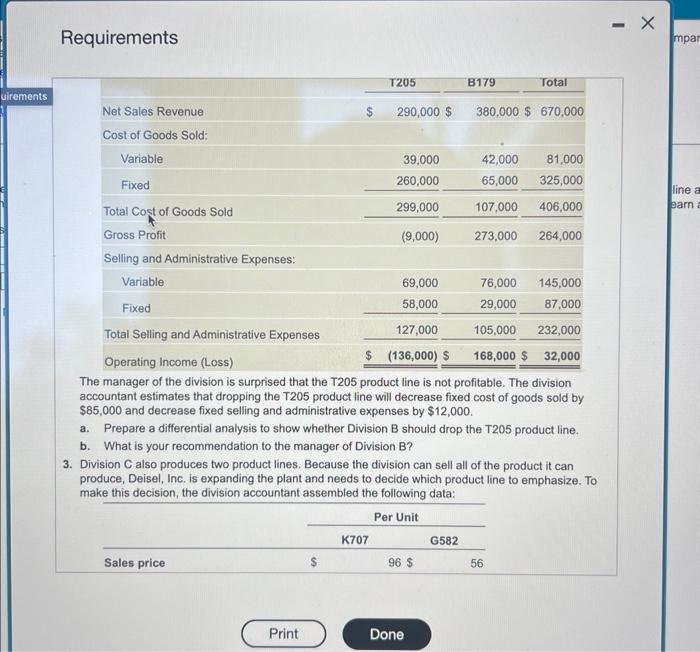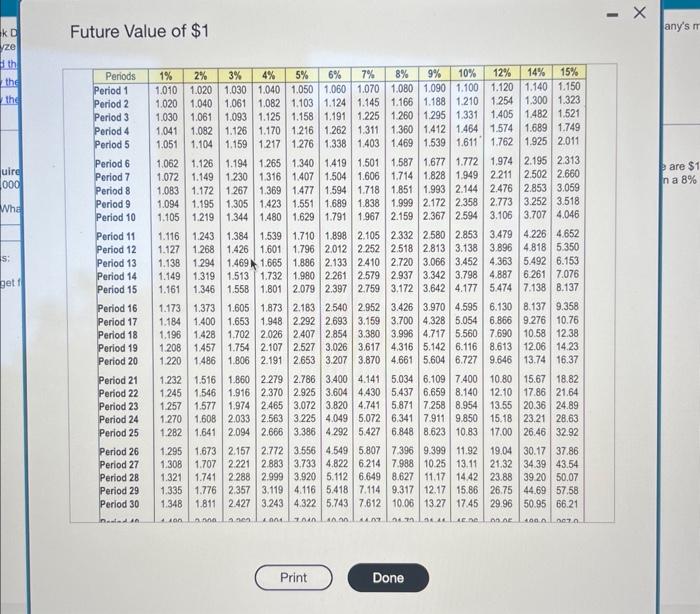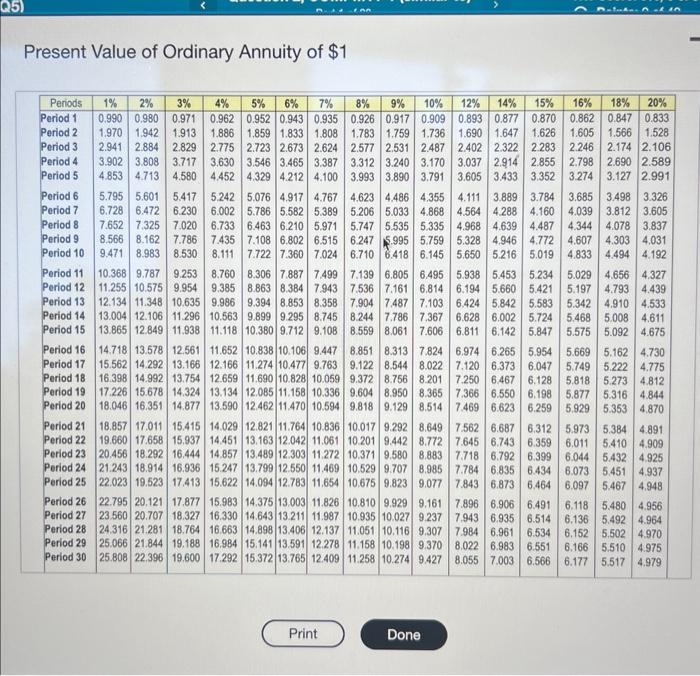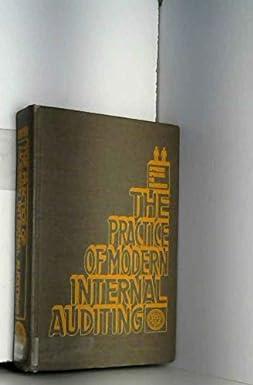Answered step by step
Verified Expert Solution
Question
1 Approved Answer
Q5 please help! Dorek Deisal, majonty stociholder and president of Deisel, Ine, is working with his top managers on future plans for the compeny, As
Q5 please help! 







Dorek Deisal, majonty stociholder and president of Deisel, Ine, is working with his top managers on future plans for the compeny, As the company/s manageral accountant, youke beell asked to onalyze the fotiowing shuations and thake recommendations to the management toan Bead the tequirements. Vew the Present Valve of 11 table. Yew the Fulven Yalue of st taste. Requirements 1. Division A of Deisel, Inc. has $5,000,000 in assets. Its yearly fixed costs are $845,500, and the variable costs of its product line are $1.35 per unit. The division's volume is currently 550,000 units. Competitors offer a similar product, at the same quality, to retailers for $3.60 each. Deisel, Inc.'s management team wants to earn a 8% return on investment on the division's assets. a. What is Division A's target full product cost? b. Given the division's current costs, will Division A be able to achieve its target profit? c. Assume Division A has identified ways to cut its variable costs to $1.20 per unit. What is its new target fixed cost? Will this decrease in variable costs allow the division to achieve its target profit? d. Division A is considering an aggressive advertising campaign strategy to differentiate its product from its competitors. The division does not expect volume to be affected, but it hopes to gain more control over pricing. If Division A has to spend $105,000 next year to advertise and its variable costs continue to be $1.20 per unit, what will its cost-plus price be? Do you think Division A will be able to sell its product at the cost-plus price? Why or why not? 2. The division manager of Division B received the following operating income data for the past year: Requirements The manager of the division is surprised that the T205 product line is not profitable. The division accountant estimates that dropping the T205 product line will decrease fixed cost of goods sold by $85,000 and decrease fixed selling and administrative expenses by $12,000. a. Prepare a differential analysis to show whether Division B should drop the T205 product line. b. What is your recommendation to the manager of Division B? 3. Division C also produces two product lines. Because the division can sell all of the product it can produce, Deisel, Inc. is expanding the plant and needs to decide which product line to emphasize. To make this decision, the division accountant assembled the following data: a. Prepare a differential analysis to show whether Division B should drop the T205 product line. b. What is your recommendation to the manager of Division B? 3. Division C also produces two product lines. Because the division can sell all of the product it can produce, Deisel, Inc. is expanding the plant and needs to decide which product line to emphasize. To make this decision, the division accountant assembled the following data: After expansion, the factory will have a production capacity of 4,100 machine hours per month. The plant can manufacture either 23 units of K707s or 50 units of 6582s per machine hour. a. Identify the constraining factor for Division C. b. Prepare an analysis to show which product line to emphasize. 4. Division D is considering two possible expansion plans. Plan A would expand a current product line at a cost of $8,410,000. Expected annual net cash inflows are $1,525,000, with zero residual value at the end of 10 years. Under Plan B, Division D would begin producing a new product at a cost of $8,250,000. This plan is expected to generate net cash inflows of $1,120,000 per year for 10 years, the estimated useful life of the product line. Estimated residual value for Plan B is $1,200,000. Division D uses straight-line depreciation and requires an annual return of 10%. a. Compute the payback, the ARR, the NPV, and the profitability index for both plans. b. Compute the estimated IRR of Plan A. c. Use Excel to verify the NPV calculations in Requirement 4(a) and the actual IRR for the two plans. How does the IRR of each plan compare with the company's required rate of return? d. Division D must rank the plans and make a recommendation to Deisel, Inc.'s top management team for the best plan. Which expansion plan should Division D choose? Why? Present Value of $1 Future Value of $1 Present Value of Ordinary Annuity of $1 Future Value of Ordinary Annuity of $1 Dorek Deisal, majonty stociholder and president of Deisel, Ine, is working with his top managers on future plans for the compeny, As the company/s manageral accountant, youke beell asked to onalyze the fotiowing shuations and thake recommendations to the management toan Bead the tequirements. Vew the Present Valve of 11 table. Yew the Fulven Yalue of st taste. Requirements 1. Division A of Deisel, Inc. has $5,000,000 in assets. Its yearly fixed costs are $845,500, and the variable costs of its product line are $1.35 per unit. The division's volume is currently 550,000 units. Competitors offer a similar product, at the same quality, to retailers for $3.60 each. Deisel, Inc.'s management team wants to earn a 8% return on investment on the division's assets. a. What is Division A's target full product cost? b. Given the division's current costs, will Division A be able to achieve its target profit? c. Assume Division A has identified ways to cut its variable costs to $1.20 per unit. What is its new target fixed cost? Will this decrease in variable costs allow the division to achieve its target profit? d. Division A is considering an aggressive advertising campaign strategy to differentiate its product from its competitors. The division does not expect volume to be affected, but it hopes to gain more control over pricing. If Division A has to spend $105,000 next year to advertise and its variable costs continue to be $1.20 per unit, what will its cost-plus price be? Do you think Division A will be able to sell its product at the cost-plus price? Why or why not? 2. The division manager of Division B received the following operating income data for the past year: Requirements The manager of the division is surprised that the T205 product line is not profitable. The division accountant estimates that dropping the T205 product line will decrease fixed cost of goods sold by $85,000 and decrease fixed selling and administrative expenses by $12,000. a. Prepare a differential analysis to show whether Division B should drop the T205 product line. b. What is your recommendation to the manager of Division B? 3. Division C also produces two product lines. Because the division can sell all of the product it can produce, Deisel, Inc. is expanding the plant and needs to decide which product line to emphasize. To make this decision, the division accountant assembled the following data: a. Prepare a differential analysis to show whether Division B should drop the T205 product line. b. What is your recommendation to the manager of Division B? 3. Division C also produces two product lines. Because the division can sell all of the product it can produce, Deisel, Inc. is expanding the plant and needs to decide which product line to emphasize. To make this decision, the division accountant assembled the following data: After expansion, the factory will have a production capacity of 4,100 machine hours per month. The plant can manufacture either 23 units of K707s or 50 units of 6582s per machine hour. a. Identify the constraining factor for Division C. b. Prepare an analysis to show which product line to emphasize. 4. Division D is considering two possible expansion plans. Plan A would expand a current product line at a cost of $8,410,000. Expected annual net cash inflows are $1,525,000, with zero residual value at the end of 10 years. Under Plan B, Division D would begin producing a new product at a cost of $8,250,000. This plan is expected to generate net cash inflows of $1,120,000 per year for 10 years, the estimated useful life of the product line. Estimated residual value for Plan B is $1,200,000. Division D uses straight-line depreciation and requires an annual return of 10%. a. Compute the payback, the ARR, the NPV, and the profitability index for both plans. b. Compute the estimated IRR of Plan A. c. Use Excel to verify the NPV calculations in Requirement 4(a) and the actual IRR for the two plans. How does the IRR of each plan compare with the company's required rate of return? d. Division D must rank the plans and make a recommendation to Deisel, Inc.'s top management team for the best plan. Which expansion plan should Division D choose? Why? Present Value of $1 Future Value of $1 Present Value of Ordinary Annuity of $1 Future Value of Ordinary Annuity of $1 







Step by Step Solution
There are 3 Steps involved in it
Step: 1

Get Instant Access to Expert-Tailored Solutions
See step-by-step solutions with expert insights and AI powered tools for academic success
Step: 2

Step: 3

Ace Your Homework with AI
Get the answers you need in no time with our AI-driven, step-by-step assistance
Get Started


